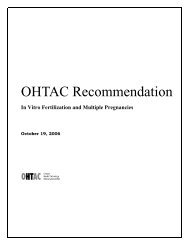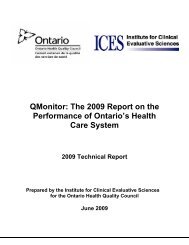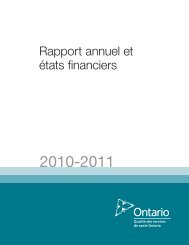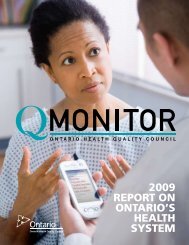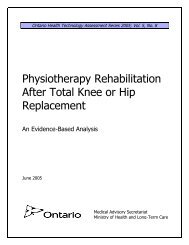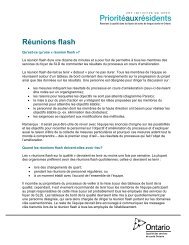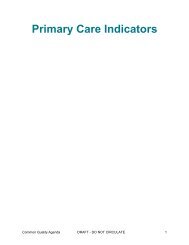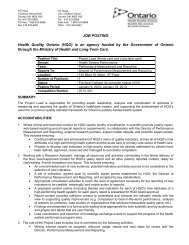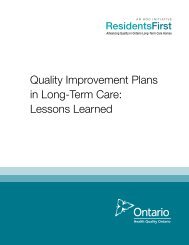Measurement for Quality Improvement - Health Quality Ontario
Measurement for Quality Improvement - Health Quality Ontario
Measurement for Quality Improvement - Health Quality Ontario
Create successful ePaper yourself
Turn your PDF publications into a flip-book with our unique Google optimized e-Paper software.
effect of a ratio. Real numbers speak more directly to the experience of<br />
your customers. How many customers are experiencing “x”? In the case<br />
of the VAP example - in the first year, two people acquired VAP and the<br />
following year four people did. Since VAPis almost always preventable, an<br />
additional two people experiencing a secondary, needless hospital induced<br />
illness, while suffering from a critical illness, is serious. Although it is useful<br />
to understand an increase in volume (as in the above example of patients<br />
waiting), it is crucial to understand the experience of each patient when<br />
conducting improvement work.<br />
Integrate measures into your daily routine.<br />
To see if changes are leading to improvement, use the “get just enough<br />
data” approach. Where measurements are gathered by auditing patient/<br />
client/resident charts, <strong>for</strong> example, decide how many charts will provide<br />
enough data <strong>for</strong> a fairly accurate depiction of your system and consistently<br />
use that number to measure over time. Graph and display your measures<br />
often enough to give your team feedback in a timely manner, both to keep up<br />
momentum and to learn of changes that are having adverse effects. Monthly<br />
graphs are often best suited <strong>for</strong> larger outcome measures whereas weekly<br />
graphs may be preferable <strong>for</strong> smaller, more variable process measures. In<br />
your quality improvement team, ensure that there is enough time allotted <strong>for</strong><br />
staff to review the results and plan the next steps.<br />
Try to build data collection into the daily routine instead of making it a<br />
separate project. This not only ensures that data is timely but also reduces<br />
stress by making measurement something that is simple to do. Create data<br />
collection <strong>for</strong>ms that include only the in<strong>for</strong>mation you need and that are<br />
easy to fill out. When integrating measurement into a staff member’s role,<br />
be sure to build in a contingency plan <strong>for</strong> ongoing collection should that<br />
person be unavailable.<br />
Plot data over time.<br />
Although one of the more common ways to collect and display data is the<br />
pre/post method (i.e., collect data be<strong>for</strong>e and after a change to the system<br />
or process), displaying data in bar charts is of limited value to improvement<br />
ef<strong>for</strong>ts because it does not answer the question “What are the effects of<br />
making this change?” Summary statistics can hide in<strong>for</strong>mation about outliers<br />
and patterns. In improvement ef<strong>for</strong>ts, changes are not fixed but continuously<br />
adapted over time.<br />
The best way to collect and display data is to use run charts and statistical<br />
control charts –graphical records of a measure plotted over time (often<br />
months). Charts annotated with changes and events provide even more<br />
in<strong>for</strong>mation and can help you more accurately make connections between<br />
interventions/events and outcomes.<br />
<strong>Measurement</strong> <strong>for</strong> <strong>Quality</strong> Improvment| <strong>Health</strong> <strong>Quality</strong> <strong>Ontario</strong> 9




